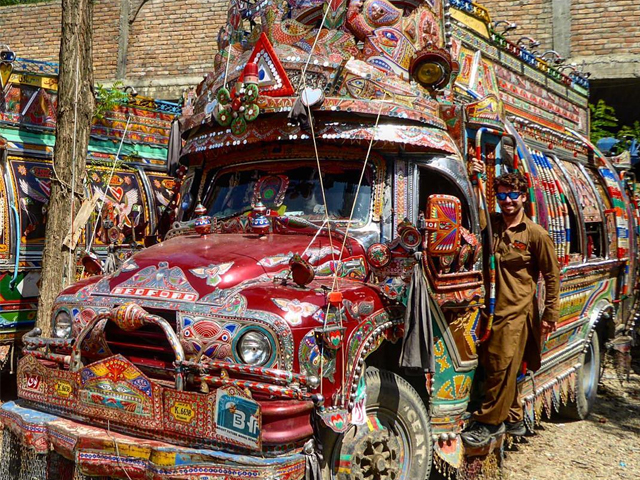
In some parts of Pakistan, especially Swat, it pays to dress a little more conservatively. PHOTO: WILL HATTON.
The best way to backpack in Pakistan, through the eyes of a foreigner
The only danger with backpacking in Pakistan is not wanting to leave.
Backpacking in Pakistan is a one of a kind adventure; this is a country which will raise many an eyebrow and steal many a heart. The only danger with backpacking in Pakistan is not wanting to leave.
Before I went backpacking in Pakistan, I was unsure what to expect. Pakistan travel advice from my government is basically one gigantic red X. The media has painted the country in an unfortunate light, a fact most Pakistanis are painfully aware of. Wherever I went, I was greeted by friendly faces and incredibly helpful people. Combine that with relatively cheap travel costs, plentiful treks and truly stunning mountains and you have one hell of a great backpacking destination.
The security situation in Pakistan is currently under control and, with the exception of the Afghanistan border regions; most of the country is perfectly safe to visit. On some occasions, you will be assigned a free police escort – read about my experience trekking with mine – to keep an eye on you but these guys are almost always super friendly and mean well.
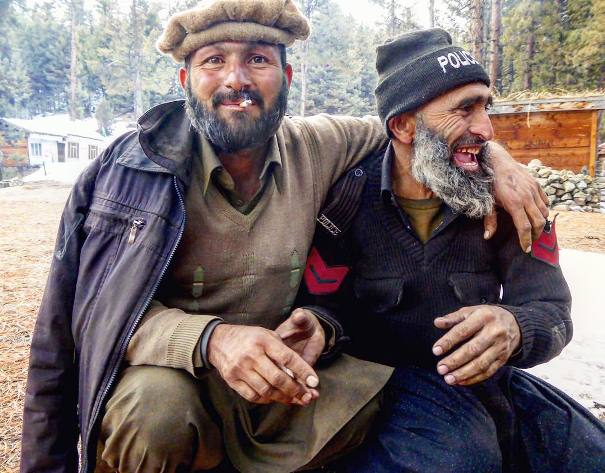 Baba laughing at a joke nobody else understood.
Baba laughing at a joke nobody else understood.Sometimes, when arriving into a new town or area, the police will insist that you stay in a certain hotel. Hotels in Pakistan are relatively expensive and to be avoided if possible; I couch-surfed my way around the country, with the help of friends from The Karakoram Club, and had a blast.
The Pakistani people are very generous and you will be plied with ridiculous amounts of free food and chai. The friends I made in Pakistan remain some of the best I have made on this trip; Pakistanis have a great sense of humour and many of them are real adventure travel enthusiasts.
Check out this video from my first trip (in February 2016) backpacking in Pakistan:

Backpacking Pakistan travel costs
Visa requirements for Pakistan
If there’s one thing that sucks about Pakistan, it’s getting hold of a visa. For most nationalities, visas can only be obtained from the embassy within your country of origin and this means that you can’t get a visa on the road. Visas are pretty expensive, for British nationals they are a whopping £100, and before you can even apply you need to get a letter of invitation (LOI) from a Pakistani tour company stating that, basically, they will accept responsibility for you. There are various Pakistani companies online offering this service and quite a few of them are very expensive, I have partnered with super-knowledgeable, super-fast Kamal who can hook you up; contact him through the form on this page.
Transport in Pakistan
There is a huge variety in transport options in Pakistan; the local Northern Areas Transport Corporation (NATCO) buses are usually the best value for money but if you want to splash out on something more comfortable go with Daewoo – I got a look inside one of the Daewoo minibuses and it was ridiculously plush. Hitchhiking in Pakistan is possible but you will encounter problems at police checkpoints. Whenever you are travelling any distance in Pakistan, you should have multiple photocopies of your passport and visa to hand over at checkpoints – on one journey, from Islamabad to Gilgit, I had to hand over a total of 11 photocopies. If you do not have the photocopies at the checkpoint, this will cause delays. Sometimes, you may need to hire a car and driver to explore an area; cars are expensive in Pakistan. To rent a car and driver for a whole day of gallivanting in Hunza, or to drive up to the China border area, costs around fifty to eighty dollars. I strongly recommend buying or renting a motorbike (Rs1,500 a day – possible from Islamabad) to explore the country. Flights in Pakistan are relatively cheap – around 80 dollars from Islamabad to Gilgit – and a good way to skip some truly horrific bus journeys.
Accommodation in Pakistan
With a few exceptions, much of the accommodation in Pakistan is fairly expensive and not particularly well set up for budget backpackers. On some occasions, the police would take me directly to a hotel and insist I stayed there; you can sometimes get out of this but other times you cannot. There are some backpacker friendly accommodations around and, during low-season anyway, it’s possible to score a room for around Rs500 (five dollars). I recommend Couchsurfing in Pakistan wherever possible – you’ll meet some amazing people – and bringing a tent for trekking.
Activities in Pakistan
The entrance to Pakistan’s most breath-taking sites, the mountains, is free. If you want to visit attractions in the cities then it usually costs foreigners Rs250 to get in. For some treks, you may need to hire a trekking guide but be sure to haggle; a fair rate for a day’s work in Pakistan is probably around Rs500 to Rs1500 a day depending on the area. I did not have to hire a trekking guide as I was lucky enough to make friends with locals along the way who showed me around for free.
Solo travel versus group tours in Pakistan
Travelling solo in Pakistan is an incredible experience but for many, it can be daunting. To help open up Pakistan, I have launched Broke Backpacker Adventure Tours to help adventurers get the most out of this amazing region.
Staying connected in Pakistan
Pakistan is a great place to unplug… partly because there’s very little Wi-Fi around and frequent power cuts in many of the mountain towns. Your best bet for staying connected is to buy a Pakistani sim card, I recommend Zong, and load it with as much data as possible. Telenor works best in the Upper Hunza area.
 The guys making use of a rare spot of signal.
The guys making use of a rare spot of signal.Backpacking Pakistan travel guide – Where to go
Lahore
The Paris of Pakistan and the starting point for many a Pakistan backpacking adventure, Lahore is one of my favourite cities in the world. The colours, the sounds, the smells, the vibrant-in-your-face-ness of it all is best experienced on the back of a motorbike; make friends with some locals and get them to show you around! Be sure to visit Badshahi Mosque; One of the most impressive sites in Lahore and the seventh largest mosque in the world, the courtyard can accommodate 100,000 worshippers and the attached museum contains many holy relics belonging to the Prophet Mohammed (pbuh). The Grand Jamia Mosque is truly stunning. It is a quiet, peaceful place that is lit up at night; I recommend an evening stroll inside. Lahore Fort is impressive and worth a visit if you have time to spare.
 The incredible Badshahi Mosque
The incredible Badshahi MosqueFor a truly unique night out, be sure to track down a Sufi dance ceremony – there is one every Thursday at the shrine of Baba Shah Jamal. Lahore has everything, even underground raves and it’s very own Eiffel tower…
When it comes to finding accommodation in Lahore; it’s easy to find a Couchsurfing host, a friend on The Karakoram Club or you could try your luck with Let’s go to Pakistan; a home-grown Pakistani initiative launched off the back of Humans of New York. Lahore Backpacker Hostel is a friendly enough place where you can crash on the floor for a couple of hundred rupees; bargain hard. From Lahore, you can catch a five hour bus to Islamabad.
Rohtas Fort
This mammoth fortress is between Islamabad and Lahore and it is possible to hitch here in just a couple of hours. I was hoping to camp within the fort grounds but the Ak-wielding security guards point blank refused me despite me trying every trick in the book. Eventually, insisting I would be eaten by wild animals, they pretty much just marched me to the entrance and told me to go back to town. I managed to hitch a lift with a couple of locals who, in normal Pakistani fashion, then insisted on taking me for dinner and dropping me at a guesthouse.
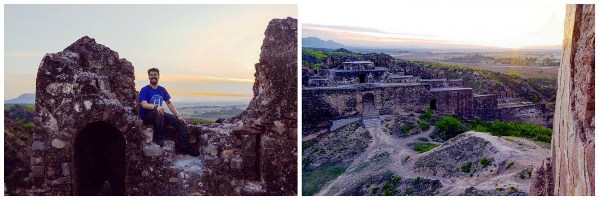 Pakistan travel experiences; watch the sunset from a fort – check!
Pakistan travel experiences; watch the sunset from a fort – check!Islamabad
The capital of Pakistan and a surprisingly clean and beautiful city, Islamabad has a few sites worth visiting but can be happily conquered in just a day. I found a Couchsurfing host with no problems. If you need a hotel, I recommend Harvey Guest House (Rs3,000 with Wi-Fi and breakfast). Centaurous Shopping Mall represents your last chance to stock up on anything you may need in the mountains. If you fly into Islamabad, a taxi from the airport to the main city is Rs800. Just a stone’s throw away from Islamabad is some woody hills and nice picnic spots, best explored with the help of a Couchsurfer and a car…
 The hills surrounding Islamabad
The hills surrounding IslamabadFrom Islamabad, your best bet is to head north. Really, most of Pakistan’s most breath-taking sites and jaw-dropping backpacking treks are in the north and in the summer the south of the country is unbearably hot anyway. From Islamabad, the bus journey to Gilgit takes eighteen hours and costs around Rs1,300. Be sure to have multiple photocopies of your passport and visa and, if possible, get a seat right at the front – the views from The Karakoram Highway are truly stunning.
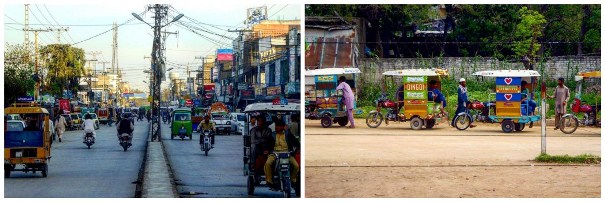 Street scenes in RawalPindi
Street scenes in RawalPindiGilgit
Arriving into Gilgit, you may encounter the police who will want you to check into a specific hotel. I managed to get out of this and went to find my own hotel, taking a taxi (Rs200) further into the main town and scoring a double room with passable Wi-Fi for Rs1,000 at Madina Two Guesthouse. There are cheaper options around, for about Rs800, but at the time I desperately needed Wi-Fi to make some Skype calls and try to sort my b**** of an Indian visa.
The nearby ‘OK restaurant’ serves up tasty yak steaks. There is not a whole lot to do in Gilgit itself unless you have a local friend to show you around; it took me ten minutes to meet a friendly dude who showed me around all day and took me to hang out with his mates in the evening. From Gilgit, you can catch buses to multiple destinations within the mountains. It is likely that you will have to return to Gilgit more than once as this is the transport hub for the Hunza region. I’ll be honest… I dislike Gilgit, try to avoid staying here if possible and simply pass through. There is a visa office in Yadgar Chowk and you can get your visa extended here in one to three days; bring your passport, passport photocopies, two passport photos and a letter from your guesthouse stating you are staying there. Gilgit has an airport.
Qasim Ali speaks excellent English and is a great guide to backpacking the Gilgit area; he can also arrange onwards travel to Skardu. He charged me nothing for a day of adventuring around Gilgit. In this situation, I tend to try to buy my new friends dinner; it’s a polite way of saying thank you. It can sometimes be very hard in Pakistan as the people are so damn generous and hospitable that they simple won’t let you pay for anything. There are lots of Couchsurfers in the Gilgit area.
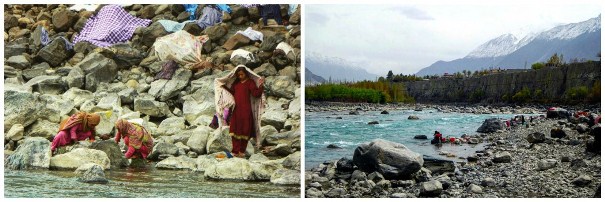 Gilgit’s river is the best place to enjoy a cup of chai and people watch…
Gilgit’s river is the best place to enjoy a cup of chai and people watch…Fairy Meadows
Catch a two and a half hour minibus from Gilgit to Raikot Bridge (going towards Chillas City) for Rs200 and check in with the police at the outpost there where you will have to hand over your passport details for the millionth time. You will then need to arrange a jeep to take you to the trailhead, the price of the jeep is an eye watering Rs7,000 so it helps if you can fill it – six passengers would be ideal. The jeep owners will insist that foreigners cannot share with Pakistanis but this is all part of the racket; after getting the friendly police to intervene I was able to share a jeep. Try to sit on the left hand side as this has the most adventurous views…
 Taking the jeep to the trailhead of The Fairy Meadows…
Taking the jeep to the trailhead of The Fairy Meadows…From the trail head, it’s a two to three hour hike to the Fairy Meadows. Anybody with reasonable fitness can do the hike but it’s also possible to rent a horse for Rs1,000 but bargain hard.
The Fairy Meadows is one of the most stunning places in all of Pakistan and you can camp here relatively cheap (but you need your own tent). Rooms are available here but are expensive – starting at Rs2,000 a night and rising all the way to Rs7,000. Despite the expense, it is well worth it to view Nanga Parbat; the ninth highest mountain in the world. You can trek to Nanga Parbat’s basecamp and do plenty of other awesome treks in the area.
 Heading into the hills…
Heading into the hills…Gulmuhammad can arrange a jeep and rents out log cabins at The Greenland Hotel which is where I recommend staying (rooms start at Rs2,000). You can buy food in the Fairy Meadows but the most basic of meals will set you back Rs500. If possible, bring a camping stove, a tent and supplies. You could easily spend a few days up there. I visited during February, which is definitely the wrong time of year to go, it was freezing; the best time of year to travel in Pakistan is between March and November. There is, apparently, sometimes electricity in the Fairy Meadows; it did not make an appearance whilst I was there. There is phone signal in one specific spot; get the local guys to show you.
There is a good chance that one of the local police officers will come along for the ride. If they like you, they may even guide you around the Fairy Meadows, they expect nothing in return but a tip of Rs500 at the end (of the total Fairy Meadows trip) is fair if they have gone above and beyond the call of duty.
I visited the Fairy Meadows again in August 2016, I highly recommend hiking to Nanga Parbat basecamp. Keen photographers should consider staying at Bial Camp; a one hour hike from the Fairy Meadows and a quieter place to camp.
 Keeping watch over the mountains
Keeping watch over the mountainsKarimabad
The jewel of Hunza and the jumping off point for more fantastic treks, Karimabad is about two and a half hours away from Gilgit by bus. The Old Hunza Inn is a fantastic place to stay with friendly vibes, gorgeous views, knowledgeable staff and occasional power. A double room (in low season) cost me Rs800. There are many fantastic things to do in Karimabad and you should definitely check out both Altit Fort and Baltit Fort for some stunning views of the ancient Silk Road leading to China. You could easily spend a few days wandering around the cobblestone streets and going on day hikes. You can arrange treks from one of the many outdoor shops that line the town.
 The stunning view from Baltit Fort
The stunning view from Baltit FortEagles Nest
For some of the most stunning views in all of Hunza, get a taxi to drive you up to The Eagles Nest and pitch your tent, or rent one (around Rs2,000) there, to spend a night – it is well worth it. It’s a 25 minute drive and a return trip costs Rs1,500.
 View from The Eagle’s Nest
View from The Eagle’s NestGhulkin
I strongly recommend staying with a local friend of mine, Rehman, in the very small village of Ghulkin, a wonderfully traditional place just a stone’s throw away from many incredible treks, glaciers, camping spots and backpacking adventures. Ghulkin is a three hour journey from Gilgit and you will pass the stunning Attabad Lake, one of the bluest lakes in the world.

To read up on my full experience staying in Ghulkin, check out my homestay in Pakistan article, which includes Rehman’s contact details. This is, hands down, the best way to see the area and was a highlight of my Pakistan backpacking adventure. Rehman’s family will provide you with a truly incredible experience and a place to sleep and food whilst you go on epic adventures upon the nearby glaciers. A donation of $10 – $20 per day per person is fair and I recommend staying three to four days. Be sure to try some dried apricots.
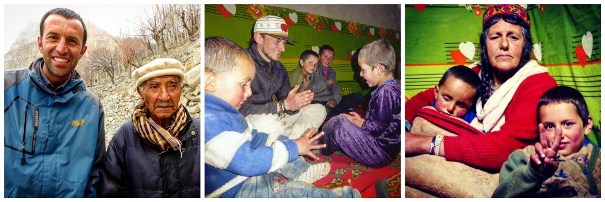
Khunjerab Pass
The highest border in the world and an incredible feat of human engineering, the road to the Pakistani-Chinese borders is full of stunning peaks and makes for a great day trip. It’s expensive to rent a car for the return trip –Rs8000 – and there is no public transport that I could find. This is an adventure best attempted if you have your own transport. I highly recommend skipping Sost (although there is an immigration office here that might be helpful for travellers heading to China) and making time to stop at Hussaini Bridge, Passu Bridge and the stunning Passu Glacier.
 Freezing my ass off at the highest border crossing in the world.
Freezing my ass off at the highest border crossing in the world.Passu Basecamp Trek
A stunning six day trek that can be done without any permits, Passu Basecamp is just one of many incredible hikes available in the area. Take a guide, I recommend Rehman.
Skardu
The town of Skardu is a popular backpacking hub and many travellers in Pakistan will find themselves here. It’s a five hour rough drive from Gilgit (expect to be thrown from side to side) by local transport (Rs500). Skardu has an airport. The prices in Skardu, especially during high season, are on the high side as this is the focal point of tourism in Pakistan. Skardu was the only place in Pakistan where I felt that the locals were interested in ripping off foreigners. In all honesty; I recommend spending as little time as possible in Skardu itself. I recommend staying, and eating, in the Diwan-e-Khas restaurant and hotel (rooms from Rs1,800). There are some cheaper options around but this is by far the best value. Mashabrum Hotel is expensive and dirty but some rooms are blessed with stunning views. Many folks rave about the views at Shangirla Resort but, to be honest, I was underwhelmed.
It’s worth taking a look at Khaplu Fort and Upper Kachura Lake, where you can swim and dine in a local restaurant on fresh-caught trout. Skardu is famous for its gemstones and crystal mines; I have heard it is possible to trek to some of these mines and get very cheap rates on precious stones – an enterprising backpacker may consider filling their backpack.
K2 Trek
An 18 day trek (doable in fourteen days if you are super fit) leading to the basecamp of the second highest mountain in the world. It’s possible to do it for about Rs150,000 but most companies will try to charge more. I do not recommend booking your trek in advance; simply rock up and sort it out in Skardu, you will get a much better price.
Deosai National Park
The best time to visit Deosai is between July and mid-august when the entire plain is covered in a blanket of stunning wild flowers. This is one of the best spots in the world to view the stars and I highly recommend camping for a night. Be careful where you pitch your tent – I was awakened by four bears a mere three meters from my camp. It costs Rs800 to enter Deosai and, unless you have your own transport, you will need to hire a jeep. Jeeps are very expensive but, if you haggle, it is possible to get an okay rate.
I managed to negotiate a jeep and driver for two nights and three days, with camping and fishing equipment thrown in, for Rs18,000. We drove from Skardu to Deosai (three hours), camped a night, and then drove to Rama Lake (four hours) where we camped again. The next day our driver dropped us to Astore and we caught a local bus to Raikot Bridge (three hours) where we caught a jeep to the trailhead for the Fairy Meadows.
 Exploring Deosai, the land of giants.
Exploring Deosai, the land of giants.Astore valley
With rolling hills and herds of horses, the Astore Valley kind of reminds me of Switzerland. There are many fantastic hikes to be had here and I highly recommend visiting Rama Lake where you can view Nanga Parbat, one of the most beautiful mountains in the world. You can camp outside the Pakistan tourism Development Corporation (PTDC) hotel in Rama for free and, from the PTDC, it’s a four kilometre journey to Rama – depending on road conditions it is sometimes possible to do two kilometres of this by jeep; my jeep became stuck for two hours, I wouldn’t recommend trying it if the roads are a river of mud.
 Nom nom nom! Meat!
Nom nom nom! Meat!Chitral and the Kalash people
The Kalash people are Pakistan’s smallest religious community and, every year, they hold a series of incredibly colourful festivals. From Gilgit, it is possible to catch a 14 hour Natco bus, crossing the stunning Shandur Pass, to Mastuj. From Mastuj, you must then take a jeep a four hour jeep to Chitral where you can visit the Kalash Valleys and stay with Engineer Khan at the Kalash Guesthouse. The Kalash people retain many of their traditional beliefs and a visit to the valley is a unique opportunity to see this small community, said to be descended from the armies of Alexander the Great. To find out more, check out this article.
Update: It is possible to get to Chitral from Swat by Jeep or from Gilgit via a Natco bus.
The Swat Valley
One of the most conservative places in Pakistan and a must-visit for keen hikers, Swat is a very interesting place indeed. All of the women here are in full-clad burqa and many of the men are not used to seeing a women’s face. The main towns are Mingora and Saidu Sharif but the real beauty of Swat is to be found in the forests.
Swat Valley was once the cradle of Buddhism and is still littered with important Buddhist monuments and relics. The Taliban invaded in 2009 and did their best to destroy the statues in the brief period they occupied the valley. They were kicked out after six months with a huge loss of lives to both Pakistani and Taliban forces, the area now has a very heavy military presence but is largely considered safe, and I encountered no problems. The most impressive of the Buddhist monuments is the towering Jehanabad Statue, try to catch it for sunset.
Whilst around Mingora, be sure to visit Udegram, an ancient Mosque, as well as Malam Jabba; the best place in all of Pakistan to catch some powder and strap on your skis. You will need your own transport whilst in Swat or to make friends with a local Couchsurfer; taxis are insanely expensive and there are not many public transport options.
Swat offers adventurous backpackers many opportunities to trek into valleys that have probably never been visited by foreigners before; I spent an incredible, yet arduous, couple of days trekking around Beshigram Lake where I stayed for free with local shepherds. The best treks in Swat are supposed to be around Kalam and Daral Lake but sadly I did not make it up that far as I was unable to find affordable transport and the heavy army presence makes hitching impossible. Multi-day rafting and trekking expeditions are possible in Swat, I met one local who had built a raft and headed down the river.
Not many travellers backpacking in Pakistan make it to Swat; officially you need a No Objection Certificate (NOC) to get in although some Pakistani locals may tell you different. One thing that does seem to be clear is that you definitely need a Pakistani friend in the region. Security is tight and you will notice the increase in machine guns and army peRsonnel – don’t photograph them. Ihsan at Swat Valley Backpackers can assist with your NOC and provide backpackers with a place to stay; I Couchsurfed with him for four days. Ihsan is a keen hiker and a conservative Muslim. Once you are in to Swat Valley you will have an incredible opportunity to meet with the local people and to explore the stunning scenery of lush green fields, glacial lakes and cloud-cropped peaks.
It’s a six hour Daewoo bus from Islamabad to Swat, Rs600, and it is also possible to get to Chitral from Swat via Kalam (10 hours) by jeep (I unfortunately had to give this a miss as the cheapest price I found was 20,000RS). If you want to head up north to Gilgit do not go back to Islamabad – instead travel from Mingora to Besham and then catch a bus from Besham to Gilgit – this will save you nearly 10 hours.
In some parts of Pakistan, especially Swat, it pays to dress a little more conservatively. Women should keep their hair covered and their body shapes hidden and men should buy a shalwar kameez; a super comfortable set of loose pyjama-like robes. Note; this only really applies to Swat…
 A peaceful place to ponder
A peaceful place to ponderPakistan Travel Guide – Tips once you’ve arrived
Visa extensions in Pakistan
It is possible to get a free two week visa extension in many places in Pakistan; I sorted mine out in just four hours in Gilgit. Skardu and Lahore also have visa offices. You can very easily extend visas by up to six months.
What to wear in Pakistan
In most of Pakistan, you can dress pretty much as you would at home although I recommend keeping tattoos covered and a tank top is an obvious mistake. Women should have a headscarf with them but will not have to wear it most of the time. Swat is a different story – be conservative in Swat. Men should buy a shalwar kameez; they are super comfy…
Women in Pakistan
In general, foreign women travelling around Pakistan will be treated with the utmost respect. If you encounter any issues simply make a scene; nearby Pakistanis will rush to your aid. I will be releasing an article soon comprised of interviews with female explorers in Pakistan packed with lots of useful info; stay tuned.
Hospitality in Pakistan
Pakistanis are a lovely bunch and are usually falling over each other to make sure you have enough chai, food and hash to keep you happy. Make an effort to get to know the locals; some of my best friends are Pakistani. I quickly learnt that everything is possible in Pakistan; even totally insane underground raves.
Tipping in Pakistan
Tipping is not expected but if you encounter amazing service or want to tip a guide then go for it – just keep the amount reasonable so other backpackers are not hit by guides expecting heavy tips. Five to 10% is plenty.
Flights in Pakistan
Several cities have airports and flights are a good way to get around and to catch some stunning mountain views. Note that flights are frequently cancelled in Gilgit and Skardu due to bad weather – the pilots operate using sight and not fancy AI equipment.
Security in Pakistan
Pakistan is one of the safest countries I have ever visited and is packed with friendly and inquisitive individuals who are always happy to meet a backpacker. The extremely helpful army and the sometimes helpful police will always keep an eye out for foreigners and they are absolutely everywhere. If you encounter any problems I suggest finding the nearest soldier; most of the officers speak some English.
Hiring a vehicle in Pakistan
Sayiah Riders, based in Islamabad, hire out motorbikes with insurance for Rs1,500 a day. Having your own transport for Pakistan is definitely the way to go as long-distance bus services are pretty uncomfortable, taxis are expensive and hitchhikers can encounter issues with curious police and army personnel. At some point you will have no choice but to hire a jeep – be sure to agree in advance that fuel is included in the cost.
 My 4×4 for my Deosai adventure
My 4×4 for my Deosai adventurePakistan Travel Guide – Getting in and out of the country
Pakistan has four land borders; India, Iran, China and Afghanistan.
I’ll give you a quick run-down of what I do know…
Border crossings between Iran and Pakistan are relatively easy but a lengthy (and hot!) experience, my buddies, Alex and Sebastian, wrote a fantastic report over at Lost with Purpose.
Border crossings between India and Pakistan are easy enough; I used the Wagah Border crossing. Getting my Indian visa whilst in Pakistan was a total nightmare and despite asking for six months (the standard Indian tourist visa) I was only granted six weeks. It took three days of hanging around the embassy to get my passport back – technically, you have to apply in Lahore and they then send your passport to Islamabad. You cannot apply in Islamabad but you can turn up at the embassy and make a fuss… I strongly recommend getting your Indian visa before you enter Pakistan as the Indian embassy in Pakistan is staffed entirely by fools.
Border crossings between China and Pakistan are simple as long as you have your Chinese visa pre-sorted. I do not know how easy it is to arrange a Chinese visa within Pakistan but the two countries have good relations so I imagine it should be doable.
Border crossings between Afghanistan and Pakistan are not advised. I looked into this for weeks but everybody I met told me that the border guards are not currently letting foreigners across and even if you do get across you will find yourself in a part of Afghanistan which is not famed for its stability. Better to enter Afghanistan from Tajikistan… that’s my plan anyway.
For more information I recommend you guys head to Caravanistan; when I myself am researching border crossings and visas, this is the site I use.
Pakistan travel information is frequently changing; I am returning to the country in 2017 and will continue to keep this page up to date.
Still not convinced? Here are 10 reasons you should travel to Pakistan!
Keen to explore Pakistan with a group of like-minded adventures; check out Broke Backpacker Adventure Tours.
All photos: Will Hatton
This post originally appeared here.

COMMENTS (12)
Comments are moderated and generally will be posted if they are on-topic and not abusive.
For more information, please see our Comments FAQ